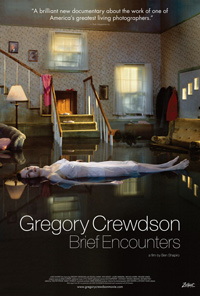Suburban Horror: Shapiro Dissects Crewdson
 Ben Shapiro’s new documentary on renowned suburban photographer Gregory Crewdson is a detrimentally revealing work the focuses on his latest body of work, ‘Beneath The Roses’, which took several year to complete and consists of about fifty massive prints that commiserate with loneliness and regret. Crewdson’s photographs are meticulously staged pieces that mimic the cinematic look of motion pictures, but lack the narrative backbone that comes with making movies. Giving a face and a background to the name, Gregory Crewdson: Brief Encounters bears bits of his upbringing and plenty regarding the process of the photographer’s hands-off approach to the artwork that carries his name, indirectly teasing out questions of authorship in art.
Ben Shapiro’s new documentary on renowned suburban photographer Gregory Crewdson is a detrimentally revealing work the focuses on his latest body of work, ‘Beneath The Roses’, which took several year to complete and consists of about fifty massive prints that commiserate with loneliness and regret. Crewdson’s photographs are meticulously staged pieces that mimic the cinematic look of motion pictures, but lack the narrative backbone that comes with making movies. Giving a face and a background to the name, Gregory Crewdson: Brief Encounters bears bits of his upbringing and plenty regarding the process of the photographer’s hands-off approach to the artwork that carries his name, indirectly teasing out questions of authorship in art.
With help from a small film crew sized collective, each enormous photo in ‘Beneath The Roses’ is taken either on a fully fabricated sound stage or in the fleeting moments of twilight with the sparest of human life standing motionless in suburbia amidst fog or staring off in decaying domestic living spaces. The images depict small town tragedy on a personal level by placing subjects alone with their own thoughts and pained faces, never interacting directly with others that may populate the frame. Like the work of Ed Burtynsky (who was featured in Manufactured Landscapes, another Zeitgeist Films release), without the large scale of the photos, these fine details would be lost, as the subjects within them are generally framed in very wide shots amongst the blight of their rural environment. Heavily influenced by the classic horror noir of Alfred Hitchcock and the suburban grotesqueries of David Lynch, Crewdson’s darkly colorful mise-en-scene conjures the same ominous moods and themes, but bypasses their narrative architecture to focus on a single manufactured moment in time.
We enter Crewdson’s world by first witnessing his crew of artisans hard at work, helping him to construct his grand vision of a scene of a warn woman exiting a taxi. These set designers, lighting technicians, and general handy men and women provide him with everything he needs. They build sets, shut down streets, light scenes from elevated bucket trucks, even take the photos for him, under his guidance of course. Crewdson and crew use high volume film cameras and the developed photos are then converted to digital for post editing by another assistant. Like the film directors he idolizes, his job seems to be less a photographer and more the creative force behind the images produced. While in most films that document the creative process of artists, this one erroneously takes away from the mystic of the photographs. Despite being the creator and organizer of these works of art, shouldn’t all of these other people that work on the project also be given credit where credit is due? Shapiro does this on a minuscule scale by introducing Richard Sands, a film cinematographer that does much of Crewdson’s lighting, as well as the photographer’s assistant, but most of the crew is left anonymous.
When not showing the production of one of many photographs or slowly zooming away from one in detail, Shapiro allows Crewdson to briefly speak of his time as a child in which his favorite memories revolved around a woodland cabin near a lake which he still frequents and how his father once took him to an exhibition of Diane Arbus photographs, unconsciously piquing his interest in the arts. His first major visual work, a series miniature dioramas, is also quickly passed over, giving texture and lineage to Crewdson’s work. While the background info serves as the foundation on which Crewdson’s career catapulted, it also feels a bit hollow, longing to be more deeply explored.
Gregory Crewdson: Brief Encounters highlights an artist taking advantage of his lack of budgetary limitations to piece together the perfect moment within a frame with help from supportive collaborators. While it seems to undercut the earnestness and conviction of Crewdson’s artistic visions by showing the man in his authoritative, yet passive process, Shapiro’s film is, at its core, about that creative process, from imaginative flicker through full on construction to the clicking of the aperture. Unfortunately, that creative process just isn’t as interesting as the dark, strangely beautiful photos themselves.


